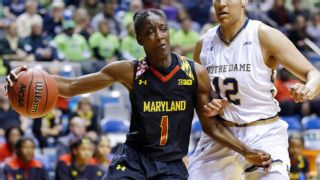 Let's face it: Sometimes the women's game can be a bit predictable. That's the not-so-dirty, not-so-little secret. The lack of intrigue at the top is generally the chief complaint of everyone from the casual fan to the not-quite-converted sports enthusiast. Exactly a year ago, the top teams were too easy to decipher. Connecticut, Notre Dame, Stanford and Duke were clear-cut No. 1 seeds, with the undefeated Huskies and Fighting Irish leading the way. Granted, South Carolina and Tennessee ultimately supplanted the Cardinal and Blue Devils when Selection Monday rolled around, but week to week, the top seeds were easy to distinguish until a Stanford/South Carolina debate right into the bracket unveiling. This season is shaping up to be a little different. At least for now. While UConn and South Carolina could be headed down a similar path as Connecticut and Notre Dame in 2014, going wire-to-wire as the top two teams (they play Feb. 9 in Storrs, Connecticut), the two remaining No. 1 seeds are much more up in the air. As many as seven teams -- Notre Dame, Tennessee, Maryland, Louisville, Baylor, Oregon State and Arizona State -- could make an argument for the two remaining No. 1 seeds. The race is that bunched, a far cry from 12 months ago. Ultimately, the Irish and the Lady Vols were the choices this week. Notre Dame has the top RPI in the country and the second-toughest schedule. Other than UConn, Notre Dame's only loss was to a rising Miami team (and without Taya Reimer, who is now back). That is an important distinction. If Reimer had not decided to rejoin the team after missing two games, the Irish would have had a much more difficult time justifying their first loss to an unranked team in three years. It would have stained the résumé much more if Muffet McGraw's team had to continue with a roster without Reimer. Despite two losses, Tennessee slides into the final No. 1 slot because its collection of wins (Texas A&M, Stanford, Rutgers and Oregon State) is better than the competition's. And it's also worth noting that the Lady Vols' two defeats (Chattanooga and Texas) came with Isabelle Harrison, the team's best player, on the sideline. The senior center is back and the Lady Vols have won 11 straight. Maryland isn't far behind, playing a difficult schedule, dominating the Big Ten, and boasting more top-50 wins than anyone in the country save Notre Dame. However, the 20-point drubbing by the Irish is a setback, and losing to Washington State (70-64 on Nov. 29) represents the worst loss for anyone in the group of contenders. The résumés of Baylor and Louisville are as similar as two teams can get, with each team's lone loss coming against Kentucky. Both lead their conferences and have winning percentages that only South Carolina, UConn, Princeton, Long Beach State and Arizona State can match. But it's the quality of wins where each just loses out on a No. 1 seed. Their best victories -- Iowa State for the Lady Bears and Iowa for the Cardinals -- just aren't good enough. But there are opportunities ahead to take down some big teams. Arizona State and Oregon State are completely new blood in any kind of discussion for a No. 1 seed. Each has just one loss and has scheduled up. The Sun Devils beat Miami, the same team that topped Notre Dame, and have four victories against teams in the field. The lone loss to Green Bay doesn't hurt, but Arizona State's collection of wins doesn't quite equal that of Notre Dame, Tennessee or even Maryland. The Sun Devils are close enough to make an argument, but not close enough to win it. The same thing can be said about Oregon State. The Beavers played well at Knoxville, but if they had been able to beat Tennessee on the road, they would have been the final No. 1 seed, not the Lady Vols. It's that close, with that many teams, making for a different narrative than most seasons -- even in January. That can only bode well for February and March.
|
